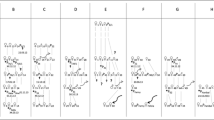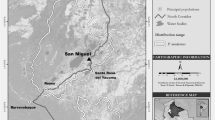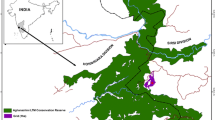Abstract
Researchers have proposed several hypotheses to explain pair-living in primates. In particular, when males are not involved in direct parental care, pair-living may be related to female dispersal, infanticide prevention, or male mate/resource defense. We aimed to evaluate, through a better understanding of the ranging patterns of avahis, which hypotheses may best account for pair-living in these nocturnal lemurs. We collected focal observations over 26 nights, June–September 2004, in a littoral forest (Sainte Luce, southeastern Madagascar) on 4 adult radiocollared avahis [Avahi laniger (Tattersall, I. (1982). The Primates of Madagascar. Columbia University Press, New York.) or Avahi meridionalis (Zaramody in Primate Reports 74:9–22, 2006)]. We followed 2 males and 2 females from 2 groups: B, a male-female couple, and A, comprising the parental pair and 1-yr-old female offspring. The adult females birthed in August. We recorded resting and feeding tree points (via global positioning system) for home range calculation through minimum convex polygon and kernel methods. We provide the first quantitative information on the ranging behavior of 2 male and 2 female avahis. Home range/daily path length values (means) are higher than the ones previously reported for the same and other folivorous pair-living lemur species. On average, the 2 females spent more time feeding and traveled shorter distances than the 2 males did. Male–female cohesion (mean values), possibly enhanced by offspring presence, was higher in A and after births than in B and before births, respectively. Although male avahis may be forced into pair-living owing to energy constraints related to size, locomotion, and diet, females might accept pair-living in exchange for indirect territory defense and mate guarding.



Similar content being viewed by others
References
Altmann, J. (1974). Observational study of behaviour: sampling methods. Behaviour, 49, 227–267.
Bollen, A., & Donati, D. (2005). Phenology of the littoral forest of Sainte Luce, Southeastern Madagascar. Biotropica, 37, 32–43.
Brockman, D. K. (2003). Polyboroides radiatus predation attempts on Propithecus verreauxi. Folia Primatologica, 74, 71–74.
Brotherton, P. N. M., Pemberton, J. M., Komers, P. E., & Malarky, G. (1997). Genetic and behavioural evidence for monogamy in a mammal, Kirk’s dik-dik (Madoqua kirkii). Proceedings of the Royal Society of London Series B - Biological Sciences, 164, 675–681.
Charles-Dominique, P., & Petter, J. J. (1980). Ecology and social life of Phaner furcifer. In P. Charles-Dominique, H. M Cooper, A. Hladik, C. M. Hladik, E. Pages, G. F. Pariente et al. (Eds.), Nocturnal Malagasy Primates: Ecology, Physiology, and Behavior (pp. 75–95). New York: Academic Press.
Clutton-Brock, T. H. (1989). Mammalian mating systems. Proceedings of the Royal Society of London Series B - Biological Sciences, 236, 339–372.
Clutton-Brock, T. H., Guiness, F. E., & Albon, S. D. (1982). Red Deer-Behavior and Ecology of Two Sexes. Chicago: University of Chicago Press.
Clutton-Brock, T. H., & Harvey, P. H. (1978). Mammals, resources, and reproductive strategies. Nature, 273, 191–195.
Curtis, D. J., & Zaramody, A. (1999). Social structure and seasonal variation in the behaviour of Eulemur mongoz. Folia Primatologica, 70, 79–96.
Demes, B., Jungers, W. L., Fleagle, J. G., Wunderlich, R. E., Richmond, B. G., and Lemelin, P. (1996). Body size and leaping kinematics in Malagasy vertical clingers and leapers. Journal of Human Evolution, 31, 367–388.
Dunbar, R. (1995). The mating system of callitrichid primates: I. Conditions for the coevolution of pair bonding and twinning. Animal Behavior, 50, 1057–1070.
Emlen, S. T., & Oring, L. W. (1977). Ecology, sexual selection and the evolution of mating systems. Science, 197, 215–223.
Emlen, S. T., & Wrege, P. H. (1986). Forced copulations and intraspecific parasitism: two costs of social living in the white bee-eater. Ethology, 71, 2–29.
Erhart, E. M., & Overdorff, D. J. (1998). Infanticide in Propithecus diadema edwardsi: An evaluation of the sexual selection hypothesis. International Journal of Primatology, 19, 73–81.
Fashing, P. J. (2001). Male and female strategies during intergroup encounters in guerezas (Colobus guereza): Evidence for resource defense mediated through males and a comparison with other primates. Behavioral Ecology and Sociobiology, 50, 219–230.
Fietz, J. (1999). Monogamy as a rule rather than exception in nocturnal lemurs: The case of the fat-tailed dwarf lemur, Cheirogaleus medius. Ethology, 105, 259–272.
Fietz, J. (2003). Primates: Cheirogaleus, Dwarf lemurs or fat tailed lemurs. In S. M. Goodman, & J. P. Benstead (eds.), The Natural History of Madagascar (pp. 1307–1309). Chicago: University of Chicago Press.
Fietz., J., & Dausmann K. H. (2003). Costs and potential benefits of parental care in the nocturnal fat-tailed dwarf lemur (Cheirogaleus medius). Folia Primatologica, 74, 246–258.
Fietz, J., Zischler, H., Schwiegk, C., Tomiuk, J., Dausmann, K. H., & Ganzhorn, J. U. (2000). High rates of extra—. pair young in the pair-living fat-tailed dwarf lemur, Cheirogaleus medius. Behavioral Ecology and Sociobiology, 49, 8–17.
Fuentes, A. (1999). Re-evaluating primate monogamy. American Anthropologist, 100, 890–907.
Fuentes, A. (2002). Patterns and trends in primate pair bonds. International Journal of Primatology, 23, 953–978.
Ganzhorn, J. U., Abraham, J. P., & Razanahoera-Rakotomalala, M. (1985). Some aspects of the natural history and food selection of Avahi laniger. Primates, 26, 452–463.
Goodman, S. M. (2003). Predation on lemurs. In S. M. Goodman, & J. P. Benstead (eds), The Natural History of Madagascar (pp. 1221–1228). Chicago: University of Chicago Press.
Gursky, S. (2000). Sociality in the spectral tarsier, Tarsius spectrum. American Journal of Primatology, 51, 89–101.
Gursky, S. (2005). Associations between adul spectral tarsiers. American Journal of Physical Anthropology, 128, 74–83.
Harcourt, C. (1991). Diet and behaviour of a nocturnal lemur, Avahi laniger, in the wild. Journal of Zoology London, 223, 667–674.
Hawkins, C. E. (2003). Cryptoprocta ferox, Fossa, Fosa. In S. M. Goodman, J. P. Benstead (eds.), The Natural History of Madagascar (pp. 1360–1363). Chicago: University of Chicago Press.
Jolly, A. (1998). Pair bonding, female aggression and the evolution of lemur societies. Folia Primatologica, 69, 1–13.
Kappeler, P. M. (1998). Nests, tree holes and the evolution of primate life histories. American Journal of Primatology, 46, 7–33.
Kappeler, P. M., & van Schaik, C. P. (2002). Evolution of primate social systems. International Journal of Primatology, 23, 707–740.
Kleiman, D. G. (1977). Monogamy in mammals. Quarterly Review of Biology, 52, 39–69.
Komers, P. E., & Brotherton, P. N. M. (1997). Female space use is the best predictor of monogamy in mammals. Proceedings of the Royal Society of London Series B - Biological Sciences, 264, 1261–1270.
Lawes, M. J., & Henzi, S. P. (1995). Inter-group encounters in blue monkeys: How territorial must a territorial species be? Animal Behavior, 49, 240–243.
Lewis, R. J. (2002). Beyond dominance: The importance of leverage. Quarterly Review of Biology, 77, 149–164.
Lewis, R. J. (2005). Sex differences in scent—marking in Sifaka: Mating conflict or mate guarding. American Journal of Physical Anthropology, 128, 389–398.
Lewis, R. J., Razafindrasamba, S. M., & Tolojanahary, J. P. (2003). Observed infanticide in a seasonal breeding prosimian (Propithecus verreauxi verreauxi) in Kirindy Forest, Madagascar. Folia Primatologica, 74, 101–103.
Martin, R. D. (1990). Primate Origins and Evolution: A Phylogenetic Reconstruction. Princeton, NJ: Princeton University Press.
Mesnik, S. L. (1997). Sexual alliances: Evidence and evolutionary implications. In P. A. Gowaty (ed.), Feminism and Evolutionary Biology: Boundaries, Intersections, and Frontiers (pp. 207–260). Georgia: University of Georgia Press.
Mitani, J. C., & Rodman, P. (1979). Territoriality: The relation of ranging pattern and home range size to defendability, with an analysis of territoriality among primate species. Behavioral Ecology and Sociobiology, 5, 241–251.
Müller, A. E. (1998). A prelimianry report on the social organization of Cheirogaleus medius (Cheirogaleide: Primates) in north-west Madagascar. Folia Primatologica, 69, 160–166.
Müller, A. E., & Thalmann, U. (2000). Origin and evolution of primate social organization: A reconstruction. Biological Reviews, 75, 405–435.
Nievergelt, C. M., Mutschler, T., Feistner, A. T. C., & Woodruff, D. S. (2002). Social system and the Aloatran Gentle Lemur (Hapalemur griseus alaotrensis): Genetic characterization of group composition and mating system. American Journal of Primatology, 57:157–176.
Norscia, I. (2006). Adaptation Strategies of a Nocturnal Lemur (Avahi laniger) in a Pluvial Littoral Forest of Southeastern Madagascar; Implications for Conservation. Italy: Ph.D. dissertation, University of Pisa.
Norscia, I. (2007). Pilot survey of avahi population (woolly lemurs) in the littoral forest fragments of southeast Madagascar. Primates doi:10.1007/s10329-007-0061-2.
Norscia, I., Carrai, V., & Borgognini-Tarli, S. M. (2006). Influence of dry season, food quality and quantity on behavior and feeding strategy of Propithecus verreauxi in Kirindy, Madagascar. International Journal of Primatology, 27, 1001–1022.
Norscia, I., Jolly, A., Rahanitriniaina, O. G., & Donati, G. (2006). Preliminary survey of lemur density in the semimontane rainforest of Anka, Fort-Dauphin region. Lemur News, 10.
Overdorff, D. J., Strait, S. G., & Telo, A. (1997). Seasonal variation in activity and diet in a small-bodied folivorous primate, Hapalemur griseus, in southeastern Madagascar. American Journal of Primatology, 43, 211–223.
Palagi, E., Telara, S., & Borgognini-Tarli, S. M. (2004). Reproductive strategies in Lemur catta: Balance among sending, receiving, and countermarking scent signals. International Journal of Primatology, 25, 1019–1039.
Palombit, R. A. (1999). Infanticide and the evolution of pair bonds in nonhuman primates. Evolutionary Anthropology, 7, 117–129.
Pereira, M. E., & Weiss, M. L. (1991). Female mate choice, male migration, and the threat of infanticide in ringtailed lemurs. Behavioral Ecology and Sociobiology, 28, 141–152.
Pimley, E. R., Bearder, S. K., & Dixson, A. F. (2005a). Home range analysis of Perodicticus potto and Sciurocheirus cameronensis. International Journal of Primatology, 26, 191–206.
Pimley, E. R., Bearder, S. K., & Dixson, A. F. (2005b). Social organization of the Milne-Edward’s Potto. American Journal of Primatology, 66, 317–330.
Powzyk, J. A. (1997). The Socio-ecology of Two Sympatric Indriids: Propithecus diadema diadema and Indir indri: A Comparison of Feeding Strategies and Their possible repercussion on species-specific behaviors. Durham, NC: Ph.D. Dissertation, Duke University.
Rasoloharijaona, S., Rakotosamimanana, R., Randrianambinina B., & Zimmermann, E. (2003). Pair-specific usage of sleeping sites and their implications for social organization in a nocturnal Malagasy primate, the Milne Edwards’ sportive lemur Lepilemur edwardsi. American Journal of Physical Anthropology, 122, 252–258.
Reichard, U. (1995). Extra-pair copulations in a monogamous gibbon (Hylobates lar). Ethology, 100, 99–112.
Ross, C. (2001). Park or ride? Evolution of infant carrying in primates. International Journal of Primatology, 22, 749–771.
Rutberg, A. T. (1983). The evolution of monogamy in primates. Journal of Theoretical Biology, 104, 93–112.
Schuiling, G. A. (2003). The benefit and the doubt: Why monogamy? Journal of Psychosomatic Obstetrics and Gynecology, 24, 55–61.
Schülke, O. (2001). Social anti-predator behaviour in a nocturnal lemur. Folia Primatologica, 72, 332–334.
Schülke, O. (2003a). To breed or not to breed — food competition and other factors involved in female breeding decisions in the pair-living nocturnal fork-marked lemur (Phaner furcifer). Behavioral Ecology and Sociobiology, 55, 11–21.
Schülke, O. (2003b). Phaner furcifer, Fork-marked lemur, Vakihandry, Tanta. In S. M. Goodman, & J. P. Benstead (eds.), The Natural History of Madagascar (pp. 1318–1320). Chicago: University of Chicago Press.
Schülke, O. (2005). Evolution of pair-living in Phaner furcifer. International Journal of Primatology, 26, 903–919.
Schülke, O., & Kappeler, P. M. (2003). So near and yet so far. Territorial pairs, but low cohesion between pair partners in a nocturnal lemur, Phaner furcifer. Animal Behavior, 65, 331–343.
Seaman, D. E., Griffith, B., & Powell, R. A. (1998). KERNELHR: A program for estimating animal home ranges. Wildlife Society Bulletin, 26, 95–100.
Southwood, T. R. E. (1996) Ecological Methods: With Particular to the Study of Insect Populations. London: Chapman & Hall.
Tattersall, I. (1982). The Primates of Madagascar. New York: Columbia University Press.
Thalmann, U. (2001). Food resources in two nocturnal lemurs with different social behavior: Avahi occidentalis and Lepilemur edwardsi. International Journal of Primatology, 22, 287–324.
Thalmann, U. (2003). Avahi, wolly lemurs, avahy, fotsy-fe, ampongy, tsarafangitra, dadintsifaky. In S. M. Goodman, & J. P. Benstead (eds.), The Natural History of Madagascar (pp. 1340–1342). Chicago: University of Chicago Press.
Thalmann, U., & Ganzhorn, J. U. (2003). Lepilemur, Sportive lemur. In S. M. Goodman, & J. P. Benstead (eds.), The Natural History of Madagascar (pp. 1336–1340). Chicago: University of Chicago Press.
van Schaik, C. P. (1989). The ecology of social relationships amongst female primates. In V. Standen, & R. A. Foley (eds.), Comparative Socioecology. The Behavioural Ecology of Humans and Other Mammals (pp. 195–218). Oxford: Blackwell.
van Schaik, C. P. (2000). Vulnerability to infanticide by males: Patterns among mammals. In C. P. van Schaik, & C. H. Janson (eds.), Infanticide by Males and Its Implications (pp. 61–71). Cambridge, U.K.: Cambridge University Press.
van Schaik, C. P., & Dunbar, R. I. M. (1990). The evolution of monogamy in large primates: A new hypothesis and some crucial tests. Behaviour, 115, 241–261.
van Schaik, C. P., & Kappeler, P. M. (1993). Life history, activity pattern and lemur social systems. In P. M. Kappeler, & J. U. Ganzhorn (eds.), Lemur Social Systems and Their Ecological Basis (pp. 241–260). New York: Plenum Press.
van Schaik, C. P., & van Hoof, J. (1983). On the ultimate causes of primates social systems. Behaviour, 85, 91–117.
Warren, R. D., & Crompton, R. H. (1997). Locomotor ecology of Lepilemur edwardsi and Avahi occidentalis. American Journal of Physical Anthropology, 104, 471–486.
Warren, R. D., & Crompton, R. H. (1998). Diet, body size and the energy costs of locomotion in salutatory primates. Folia Primatologica, 69, 86–100.
Wittenberger, J. F., & Tilson, R. L. (1980). The evolution of monogamy: Hypothesis and evidence. Annual Review of Ecology and Systematics, 11, 197–232.
Wrangham, R. W., & Rubenstein, D. I. (1986). Social evolution in birds and mammals. In D. I. Rubenstein, & R. W. Wrangham (eds.), Ecology and Social Evolution: Birds and Mammals (pp. 452–470). Princeton, NJ: Princeton University Press.
Wright, P. C. (1986). Ecological correlates of monogamy in Aotus and Callicebus. In J. Else, & P. Leein (eds.), Primate Ecology and Conservation (pp. 159–167). Cambridge, U.K.: Cambridge University Press.
Wright, P. C. (1990). Patterns of parental care in primates. International Journal of Primatology, 11, 89–102.
Wright, P. C. (1999). Lemur traits and Madagascar ecology: Coping with an island environment. Yearbook of Physical Anthropology, 42, 31–72.
Wronski, T., & Apio, A. (2005). Home range overlap, social vicinity and agonistic interactions denoting matrilineal organization in bushbuck, Tragelaphus scriptus. Behavioral Ecology and Sociobiology doi:10.1007/s00265-005-0128-2.
Zaramody, A., Fausser, J. L., Roos, C., Zinner, D., Andriaholinirina, N., Rabarivola, C. et al. (2006). Molecular phylogeny and taxonomic revision of the eastern woolly lemurs (Avahi laniger). Primate Reports, 74, 9–22.
Acknowledgments
We thank the Commission Tripartite du Département des Eaux et Forêt, the Parque Botanique et Zoologique de Tsimbasasa, and the Université d’Antananarivo for research permits; Jean-Baptiste Ramanamanjato, Manon Vincelette, and the staff of the conservation section of QMM for providing support for our research; Givet, Kadoff , Roline, and Josette, for their invaluable help in the field; and the people of the villages of Ambandriky and S. Luce for providing assistance when needed.
We also thank Joerg Ganzhorn for the possibility of doing this research in the field (part of the Ph.D. program of I. Norscia), Giuseppe Donati for opening the door of Sainte Luce, Stacey Schmidt for the first linguistic revision, Barbara Leporini for data elaboration support, and Elisabetta Palagi for providing useful discussion on the manuscript. Finally, we thank the 2 anonymous reviewers who improved the manuscript with their comments and suggestions. This research was partly funded by MIUR.
Author information
Authors and Affiliations
Corresponding author
Rights and permissions
About this article
Cite this article
Norscia, I., Borgognini-Tarli, S.M. Ranging Behavior and Possible Correlates of Pair-Living in Southeastern Avahis (Madagascar). Int J Primatol 29, 153–171 (2008). https://doi.org/10.1007/s10764-007-9219-4
Received:
Revised:
Accepted:
Published:
Issue Date:
DOI: https://doi.org/10.1007/s10764-007-9219-4




